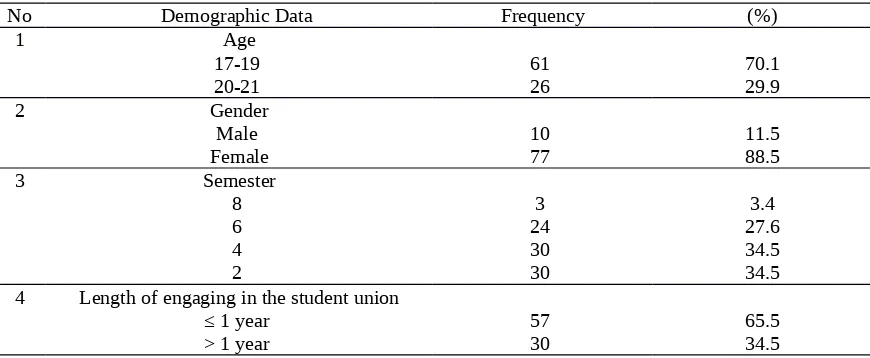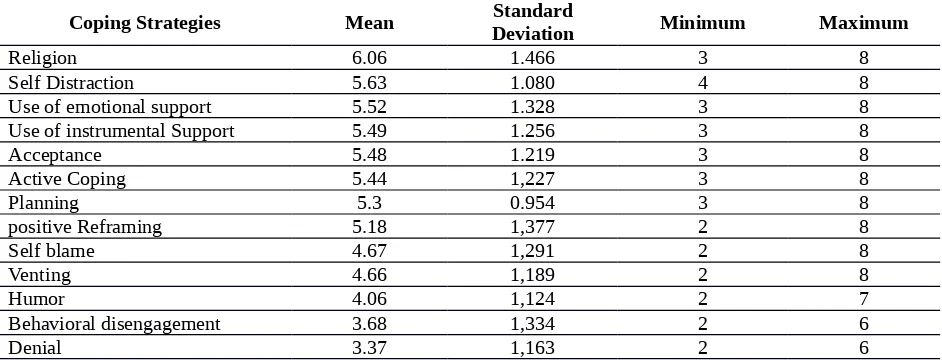Stress Level and Coping Strategies Among Nursing Students Engaged in Student Union
Nunun Pratiwi1, Muhammad Mu'in2
Nursing Department of Medical Faculty of Universitas Diponegoro 1 (email: tiwigunawan9@gmail.com) 2) (email: aq1lafw@gmail.com)
Abstract
Extracurricular activities or student union is a means for students to develop their interests, talents, and potentials. Student involvement in the student union can cause stress such as pressure to accomplish tasks and responsibilities within the limited time period, besides stressors from curricular tasks. Aim of this study was to describe stress and coping strategies Among students engaged in student union. This study used a cross-sectional descriptive method using accidental sampling Consist of 87 respondents. Data Collected used DASS stress levels and Brief COPE for coping strategies. Result Showed that most of respondents experience stress in a normal stress level by 44.8%. Religious was the highest average value (6:06) of coping strategies used by students. Its needed for student engaged in student union to learn and practice effective coping strategies to deal with high stressors as multiple tasking student.
Keywords: Level of Stress, Coping Strategies, Student Union .
Purpose
This Study Aimed to know stress level and coping strategies used by students engaged in the student Body/ union.
Background
Student has important role as an agent of change with their talent and capabilities in directing better condition of the nation (Ahmad, 2014). These can be developed by engaging in the student union. Activities in the student union has positive impact by increasing knowledge beside academic standards, allowing them to practice effective time management, increasing emotional quotient, and enhancing soft skills capabilities.
avoidance coping meaning escape from an unpleasant situation by concerning themselves to other activities, such as listening music, singing, sleeping, and walking around (Dayfiventy & Nurhidayah, 2012).
Design
This research uses descriptive quantitative method used cross-sectional study design.
Method
Population in this study is student who engaged in one of the student union in School of Nursing Universitas Diponegoro. Sampling techniques with accidental sampling, respondents who took part of the organization that are in Semarang by 87 respondents. Stress levels measured by DASS, while coping strategies used the Brief Cope questionnaire.
Result
Table 4.1 Distribution of Demographic Data of Student Engaged in One of Student Union of School of Nursing Universitas Diponegoro, 2014 (n = 87)
No Demographic Data Frequency (%) 4 Length of engaging in the student union
≤ 1 year
> 1 year 57 30 65.534.5
Table 1. showed that of 87 respondents, the largest percentage characteristics of student in this study were 17-19 years consist of 61 student (70.1%), female 77 student (88.5%), four and two semesters were 30 student (34.5%), length of engaged with student union by ≤ 1 year were 57 students (65.5%).
Table 4.2. Distribution of Stress Levels among Students Engaged in One of Student Union of School of Nursing Universitas Diponegoro, 2014 (n = 87)
Table 2. indicates stress level of students were 44.8% of respondents experienced normal stress levels. Table 3. Distribution of Coping Strategies among Students Engaged in One of Student Union of School
of Nursing Universitas Diponegoro, 2014 (n = 87)
Coping Strategies Mean DeviationStandard Minimum Maximum
Religion 6.06 1.466 3 8
Self Distraction 5.63 1.080 4 8
Use of emotional support 5.52 1.328 3 8
Use of instrumental Support 5.49 1.256 3 8
Acceptance 5.48 1.219 3 8
Table 4. showed that the highest average value of coping strategies is religion coping consist of 6.06 and the lowest average is Denial coping consist of 3:37
The average age of students respondents was 17-19 years consist 61 students. Age related to one's experience facing wide variety of stressors, ability to utilize support sources and better skills to manage stress (Sundeen, Laraia, 2005). Study by Furyanto (2012) show that among teenagers generally age didnt corelate with different uses of coping strategies if they were at same educational level. Most of students engaged in student union were female. Level of stress occurs among female tends to be higher than in men, it is because female more often used task-oriented coping mechanisms, so they more easily identify if being in stress conditions. While male tend to use ego oriented, so they are is more relaxed when facing stressor (Baldwin, 2002). Most of students were in semester four and two. Study showed that students whether in semesters two or four, none of them are resistant to stress, eventhough semester four students less experienced stressor than two (Muhammad, 2011).
(Liu, Gu, Wong, Luo, Chan, 2014; Pulido-Martos, Augusto-Landa, Lopez-Zafra, 2011). In clinical setting 47,82 % nursing student had stress level above mean related to assignment, patient care, nursing staff and teachers (Khater, Akhu-Zaheya, Shaban, 2014). Activities in student union may increase stressors eventhough in this study in majority still at normal level.
The sequence of coping strategies used by student were Religion, Self Distraction, Use of emotional support, Use of instrumental Support, Acceptance, Active Coping, Planning, positive Reframing, Self blame, Venting, Humor, Behavioral disengagement, and Denial. Kumar and Nancy (2011) found the same that most of coping strategies used by nursing student was positive coping but with different order with the most common coping stregy used was seeking diversion and the least used is seeking professional support. Khater, Akhu-Zaheya, and Shaban (2014) also found that most of coping strategies used by nursing student in clinical setting was positive i.e problem solving.
Engagement in student union should be recommended for nursing student because of its positive impact, eventhough it may increase level of stress. This is not significancy related to the output of the academic result. Study by Febriana, Betie, Amriyatun, Winanti and Amelia (2013) showed that there is no differences of grade point between student engaged in student union and who not engaged.
Study results showed that the most coping strategies used was Religion with average value by 6.06. According to Pargament religious coping is an attempt to understand and tackle the sources of stress in life by performing a variety of ways to strengthen the individual's relationship with God. Furthermore, Pargament explained that the diversity of religious coping viewed by individuals, situations and cultures that make up the various religious coping. Students who have religious coping has a low level of stress. Individuals who have a religious coping will make efforts to demonstrate the expression of spirituality and strengthen spiritual ties. It is due to the belief that there is meaning in individual lives as God's creatures, so individual will tend to strengthen his relationship with God. While individual spiritual relationship to others include support spiritual derived from the environment, which it will impact on the response in the face of stressful situations. Individuals who have a positive religious coping will have a positive impact also on his relationship with God and his relationship with environment. (Pargament, 2011). While denial coping is at last sequence coping used. Denial is a condition in which individuals reject the existing problems assuming as if an individual problem does not exist, meaning that individual ignores the faced problems (Sarafino, 2006).
Conclusions
Most of student who engaged in student union were in normal stres level and most of coping strategies used was religious coping, and the least was denial. Student should wisely decide to engage in student select ed and practiced effective coping mechanisme to deal with academic and extracurricula stressor.
References
D, Baldwin. R. 2002. Stress and illnes in Adolescence: Issue of Race and Gender. http://www.fidarticles.com/ [on-line]
Govaerst, S. & Gregoire, J. stressfull Academic Situations: Study On Appraisal Variable In Adolescence. Britiish Of Clinical Psycology, 2004: 54; 261-267
Dayfiventy Yemima, Rika Endah Nurhidayah. 2012. Stressor Dan Koping Mahasiswa Pembelajaran Kurikulum Berbasis Kompetensi Fakultas Keperawatan Universitas Sumatera Utara. Jurnal USU
Febriana, Betie, Amriyatun, Luky Winanti & Sandra Amelia. Hubungan Antara Keaktifan Organisasi dengan Prestasi Belajar (Indeks Prestasi) Mahasiswa Fakultas Ilmu Keperawatan Universitas Indonesia. Jurnal Prosiding Konferensi Nasional Ppni Jawa Tengah 2013. No 154-157. Accessed via: http:// www.jurnal.unimus.ac.id
Furyanto. 2012. Hubungan fungsi afektif keluarga dengan strategi koping remaja di SMP Diponegoro 1 Purwokerto. diakses melalui: http://keperawatan.unsoed.ac.id/sites/default/files/Furyanto%.pdf
Kumar, R and Nancy (2011) Stress and Coping Strategies among Nursing Students. Nursing and Midwifery Research Journal. Vol-7 No 4 October 2011
Khater, W.A; Akhu-Zaheya, L.M; Shaban, I.A (2014). Sources of Stress and Coping Behaviours in Clinical Practice among Baccalaureate Nursing Student. International Journal of Humanities and Social Science. Vol. 4 No. 6 April 2014
Labrague, L.J (2013) Stress, Stressors, and Stress Responses of Student Nurses in a Government Nursing School. Health Science Journal. Volume 7 Issue 4
Liu, M; Gu, K; Wong, TKS; Luo, M.Z; Chan, M.Y (2014) Pereceived Stress among Macao Nursing Students in the Clinical Learning Environment. International Journal of Nursing Science 2 (2015) 128-133.
Muhammad, Jusuf Isman. Profil Tingkat Stress Pada Mahasiswa Program Studi Ilmu Keperawatan SI Universitas Gorontalo. Jurnal Health & Sport,Vol II, Nomor 1. Feb. 2011:67-126
Pargament, KI, Feuille, M., & Burdzy, D. (2011). The Brief RCOPE: current psychometric status of a short measure of religious coping. Journal of religions, 2, 51-76.
Pulido-Martos, M; Augusto-Landa, J.M; Lopez-Zafra, E (2011). Sorces of Stress in Nursing Student: A Systematic Review of Quantitattive Studies. International Nursing Review. International Council of Nurses Sarafino, E.P. 2006. Interaction Biopsychososial Health Psychology. (5th Edition). USA: John Wiley & Sons, Inc.

